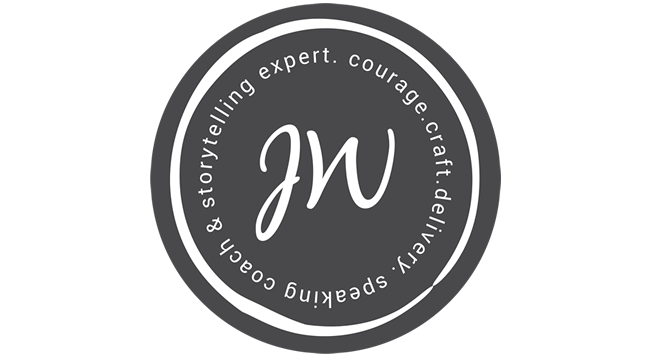To PowerPoint or not to PowerPoint?
October 22nd, 2019

Here’s a little pop quiz: You have a presentation to give. The date is on the calendar and getting closer. You sit down to work on your talk. What’s the first thing you do?
A. Go to the kitchen and eat some potato chips, then see that the garbage needs to be taken out but on your way outside you notice the pile of laundry you had started earlier which you decide to throw in the washing machine, which is by the window, which looks out onto the garden, and then you find yourself out in the garden weeding for the rest of the day. Did you say presentation?
B. Open up PowerPoint and start building your slide deck
C. Pull out your pad of sticky notes and put a big piece of chart paper up to start brainstorming ideas & stories.
D. Take a walk and start walking your talk
What’s your preferred method of beginning?
I’m gonna vote for C or D as the most effective ways to begin. I’ve certainly started enough talks with the A method, and they turn out OK. I suspect the idea is still in there stewing and cooking even when I’m letting my squirrel mind follow every impulse.
The only one I’m voting a hard no for is B.
If you plan to use slides (we’ll get to the whether or not later) please please please don’t start there.
Start with your message.
Always always always start with your message.
When that’s clear, then you can decide whether or not slides will support your message.
Let’s take a step back and look at some key points to consider when you’re determining whether or not to use slides.
Then, if you DO choose to use slides, we’ll take a look at how to make your slides visually interesting and supportive of your idea rather than distracting from your idea.
Just don’t do it.
For years I didn’t use slides, and still only use them sometimes. When I’m working with new speakers, I encourage them not to use them at all to start.
So many new speakers use slides as a crutch, as notes for you to follow. The clicker becomes your safety net, and the slides end up being a thin (or thick) veneer between you and your audience.
If something goes wrong with technology, you’re doomed.
Plus, as a new speaker, you want to get solid practice connecting with your audience without the crutch of a slide AT ALL. Feeling all the feels that come with speaking. Owning the stage AS YOU, not as someone who advances slides and regurgitates what’s on the slide.
YOU showing up fully, delivering a clear message, connecting with your audience is WAY more important than spending hours building fancy slides, so put your efforts there. When you’ve got that dialed in, then we can talk about slides.
When you DO use slides, consider these tips:
Keep it simple. No more than 10 words per slide. Yep. No more than 10. Sometimes just 1 or 2. A key idea. A word you want me to remember. I’m listening to you, so I want to be able to glance at the slide and get the big picture idea of what you’re talking about.
Give your audience time to process what’s on the slide. First of all, see point 1 above. But if you insist on having more than 10 words on a slide, then you’re gonna have to give me time to read & process all that information.
I can’t read it AND listen to you at the same time, which means there’s a good chance I’m gonna tune you out for a minute and read what’s on the slide.
Here’s a great way to gauge if there’s too much info on the slide: If Stop talking, and give me in the audience time to read the slide. If you find yourself standing there waiting way too long, this could be a signal that there’s too much information on the slide. You need to kill your darlings and boil it down to its essence.
Use images to paint a visual picture. One of the great things that slides do provide is another way for our brain to relate to the information. So rather than filling your slides with notes from what you’re saying, ask yourself “What can my slide say that I’m not saying?” A picture can paint a thousand words, so what’s the picture that paints an image of your idea?
Use slides the way you use vocal dynamics. When I teach vocal dynamics in Speaker’s Playground, I talk about how the dynamics of your voice communicates to your audience what’s important, what to listen to, when to soften my heart, when to wake up my brain. Your dynamics lead the way of my attention. Slides serve the same purpose. Your slides aren’t just a collection of information you’re going to read off to me, but they communicate what’s important. They tell me how to listen.
It’s OK to repeat a slide. Not only OK, but super effective. Any time you return to the Big Idea, or the Genie Gem as I like to call it, you can return to the same slide. The audience has seen it before. Our brains like to see things again. It helps us remember what we’re learning. It communicates that what we’re seeing is really important. It sinks the idea in even deeper so that ONE THING you want us to remember, we actually remember.
“But my audience wants me to share my slides with them so it’s gotta have all the info!” It’s great that you have valuable info that your audience will want access to after your presentation. But the slides you share with your audience afterwards don’t have to be the same slides you use for your presentation. You can have an expanded version of your slides to share, and an essential version you use for your talk. That way your slides support your talk while you’re giving it, and your audience still gets all the info they need afterwards.
“But I use my slides to help me remember what I’m saying!” I get it. When I use slides, they help keep me on track, too. But it’s the key ideas on the slides that keep me on track. I’m not reading my talk off of the slides. If you need that level of detail on your slides just to remember what you’re saying, then my diagnosis is that you haven’t spent enough time practicing. Let the big idea of the slide point you to where you need to go in the big map of your talk. But beyond that, learn what you want to say about the key ideas so it’s in your bones, not on the slides.
Don’t compete with your slides. It’s ok to pause and gesture towards the slide and tell me to bring my attention to the slide. That will give you a break in delivering and your audience a break in processing. It will also communicate the value of what’s on the slide, which sends a message that it’s not just filler, but something truly worthy of my attention. If you’re making a key point in your talk, let your slides go black. That also sends a message that you want ALL of my attention on you for this central point.
Always have a back up. You never know when technology is gonna go kaput on you and leave you without any access to your slides. Your job is to stay relaxed, and continue rolling in your talk, delivering value and connecting with your audience. Have note cards available, or a white board, so that you can seamlessly move through the minor obstacle without freaking out. And keep doing your job of delivering value.
Remember, you’re building a relationship. Whether your goal is to make a sale, get an investor, or change the mind of your audience, you need to build a relationship to get that yes.
YOU come before the slides in that relationship, so be sure that you put YOURSELF front and center, and create slides that enhance and clarify the idea you’re communicating.
And always remember it’s absolutely okay NOT to use slides. Connection first. Slides second. If your slides don’t make your presentation stronger, then don’t use them. Your presence is way more important.
How about you? Do you use slides? Love em or hate em?
One response to “To PowerPoint or not to PowerPoint?”
Leave a Reply
« When Public Speaking Fear Gets the Best of You | Your Body Says it All »


 FACEBOOK
FACEBOOK INSTAGRAM
INSTAGRAM LINKEDIN
LINKEDIN SUBSCRIBE
SUBSCRIBE
Thanks Johanna. This was so helpful. I feel like I have evolved so much in my presentations and you have been quite inspiring to me. This was perfect!